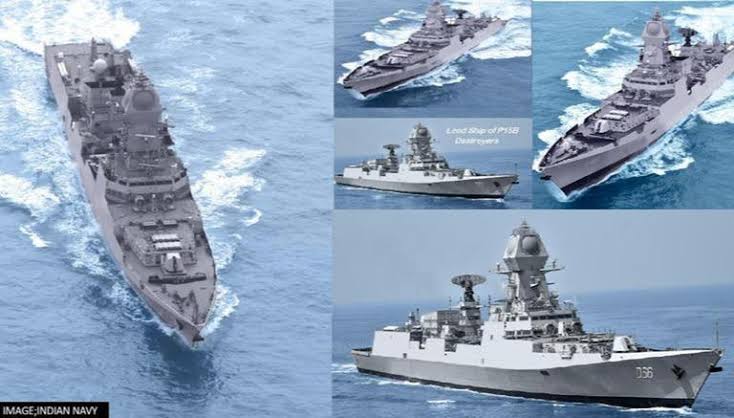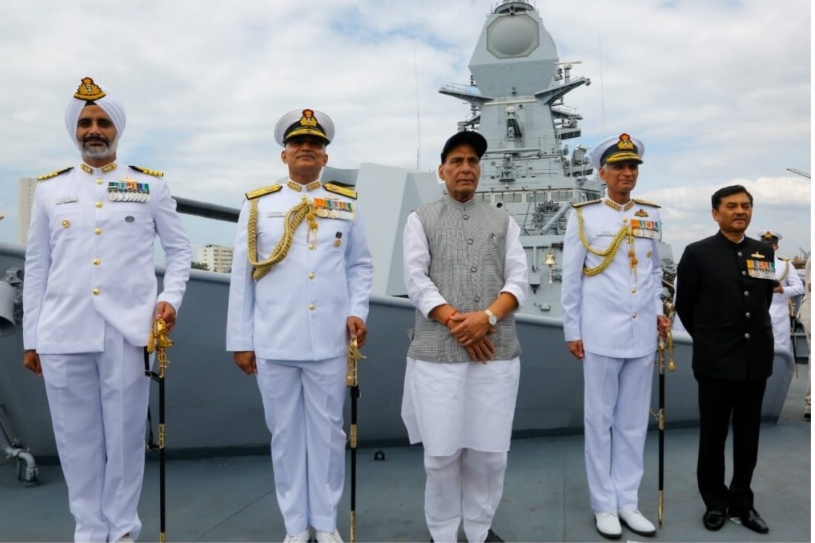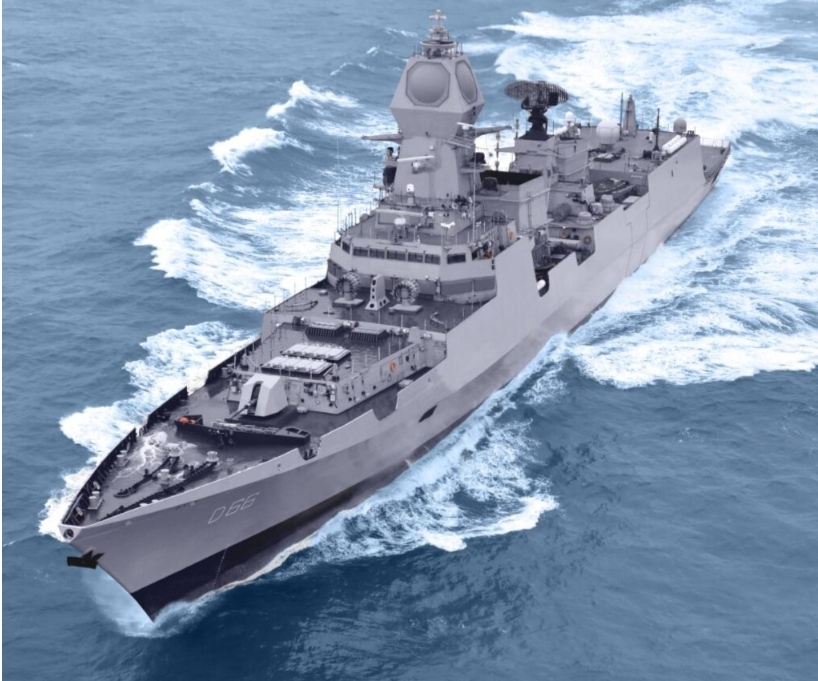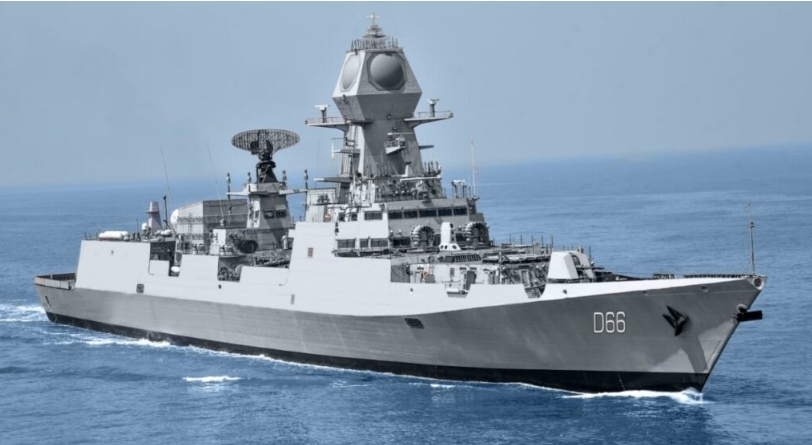INS VISAKHAPATNAM Joins The Indian Navy

With INS VISHAKHAPATNAM getting commissioned into the Navy, the destroyer strength has gone up to ten. In next two years three more ships of this class will be joining too, namely MURMAGAO, PORBANDAR and IMPHAL. However by that time at least two of the three remaining RAJPUT class destroyers will have retired leaving the Navy with just 11 destroyers.
The Indian Navy presently needs 8x destroyers with each of its two fleets and 3x destroyers for the two flotillas- Southern Naval Flotilla and Andaman & Nicobar Flotilla. This makes it a total of 22 destroyers.
How do you get these additional 12 destroyers (last of the RAJPUT Class will also retire soon ) for our Navy by 2032? By placing orders on both Mazagaon and Garden Reach for 4x destroyers each and another 4x destroyers to be manufactured by a selected private firm.
The induction of INS VISHAKHAPATNAM was termed by the Raksha Mantri as a symbol of the growing maritime prowess of the country and a major milestone in achieving our vision of ‘Make in India, Make for the World’. He added that the ship is a reminder of ancient and medieval India’s maritime power, shipbuilding skills and glorious history. The ship is one of the most technologically advanced guided missile destroyers in the world which will cater to the present & future requirements of the Armed Forces and the Nation as a whole.
Visakhapatnam the first of four vessels was laid down in October 2013 and launched in April 2015. It was followed by the future INS MURMAGAO which was launched in September 2016. The third destroyer, IMPHAL, was launched in April 2019. The fourth and final vessel of the class will be PORBANDAR which is expected to be launched next year. All four destroyers are being built at MDL.
The Project 15B (P15B) / Visakhapatnam-class with the latest design currently under construction have been designed indigenously by the Indian Navy’s Directorate of Naval Design, New Delhi. Each ship spans 163 metres in length and 17.4 metres at beam and displaces 7,300 tonnes. These ships will be propelled by four gas turbines to achieve speed in excess of 30 knots.
The P15B destroyers incorporate new design concepts for improved survivability, sea keeping, stealth and manoeuvrability. Enhanced stealth features have been achieved through shaping of hull and use of radar transparent deck fittings which make these ships difficult to detect. The design around the bridge area appears to be main design change compared to the preceding Kolkata-class. P15B ships will be equipped to carry and operate two multi-role helicopters.
The Visakhapatnam-class shares several sensor and weapon systems with its preceding design, the Kolkata-class (Project 15A) of destroyers: The IAI EL/M-2248 MF-STAR S-band AESA multi-function radar, Thales LW-08 D-band air search radar, BEL HUMSA-NG bow sonar are fitted on both classes. Like Project 15A, the Project 15B will be fitted with 32x Barak 8 surface to air missiles (launched from VLS cells) as well as 16 BrahMos anti-ship and land-attack cruise missiles.

The Raksha Mantri praised the Indian Navy’s consistent efforts to participate in various outreach programmes of the industries and increase indigenised items under ‘Float’, ‘Move’ and ‘Fight’ categories. Stressing on the need to maintain the momentum, he expressed confidence that “the steps taken by the government will continue to provide boost to the self-reliance efforts and we will soon build ships not just for India, but for the entire world”. He assured of Government’s continuous support to achieve this vision.
Shri Rajnath Singh also exhorted the public & private sector to take advantage of Government’s policies, work together and make India an indigenous shipbuilding hub. He listed out a number of reforms undertaken by the Government through which the public and private sector companies can make their mark in the international market.
The latest destroyer is 163m in length, 17m in breadth and has a displacement of 7,400 tonnes and is one of the most potent warships to have been constructed in India. The ship is propelled by four powerful Gas Turbines, in a Combined Gas and Gas (COGAG) configuration, capable of achieving speeds in excess of30 knots. The ship has enhanced stealth features resulting in a reduced Radar Cross Section (RCS) achieved through efficient shaping of hull, full beam superstructure design, plated masts and use of radar transparent materials on exposed decks.
The ship has most sophisticated state-of-the-art weapons and sensors such as Surface-to-Surface missile and Surface-to-Air missiles. It is fitted with a modern surveillance radar which provides target data to the gunnery weapon systems of the ship. The anti-submarine warfare capabilities are provided by the indigenously developed rocket launchers, torpedo launchers and ASW helicopters. The ship is equipped to fight under Nuclear, Biological and Chemical (NBC) warfare conditions.

INS Visakhapatnam during sea trials
A unique feature of this ship is the high level of indigenisation incorporated in the production. Some of the major indigenised equipment/system onboard INS VISHAKHAPATNAM include Combat Management System, Rocket Launcher, Torpedo Tube Launcher, Integrated Platform Management System, Automated Power Management System, Foldable Hangar Doors, Helo Traversing system, Close-in Weapon System and the Bow mounted SONAR.
The ship has a total complement of about 315 personnel. Enhanced crew comfort is a significant feature which has been ensured through ergonomically designed accommodation based on ‘modular’ concepts. The ship will be under the command of Captain Birendra Singh Bains, a Navigation & Direction specialist.

INS VISHAKHAPATNAM




